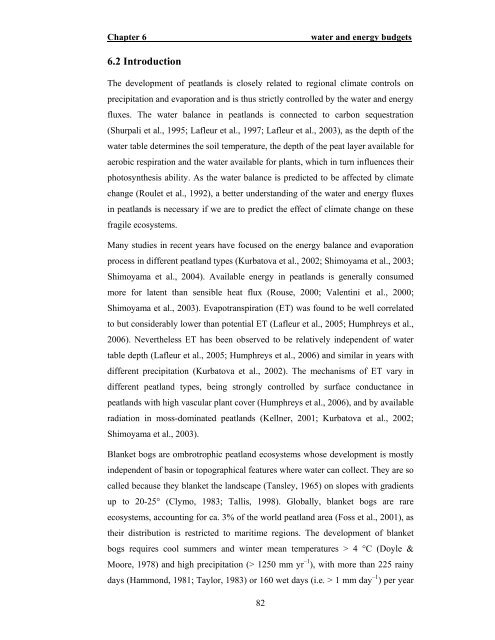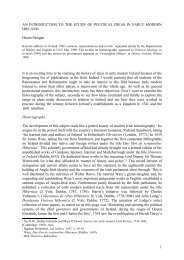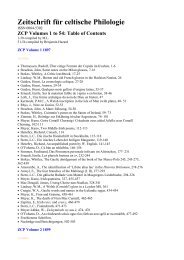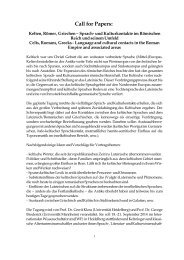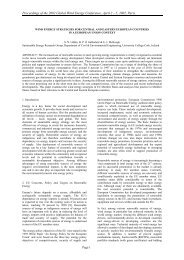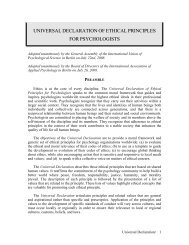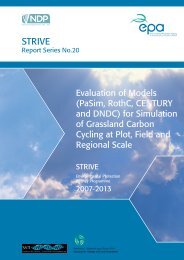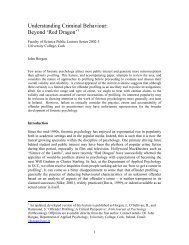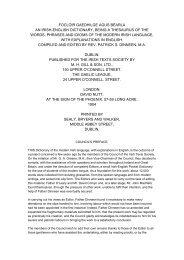PhD Thesis, 2007 - University College Cork
PhD Thesis, 2007 - University College Cork
PhD Thesis, 2007 - University College Cork
You also want an ePaper? Increase the reach of your titles
YUMPU automatically turns print PDFs into web optimized ePapers that Google loves.
Chapter 6<br />
water and energy budgets<br />
6.2 Introduction<br />
The development of peatlands is closely related to regional climate controls on<br />
precipitation and evaporation and is thus strictly controlled by the water and energy<br />
fluxes. The water balance in peatlands is connected to carbon sequestration<br />
(Shurpali et al., 1995; Lafleur et al., 1997; Lafleur et al., 2003), as the depth of the<br />
water table determines the soil temperature, the depth of the peat layer available for<br />
aerobic respiration and the water available for plants, which in turn influences their<br />
photosynthesis ability. As the water balance is predicted to be affected by climate<br />
change (Roulet et al., 1992), a better understanding of the water and energy fluxes<br />
in peatlands is necessary if we are to predict the effect of climate change on these<br />
fragile ecosystems.<br />
Many studies in recent years have focused on the energy balance and evaporation<br />
process in different peatland types (Kurbatova et al., 2002; Shimoyama et al., 2003;<br />
Shimoyama et al., 2004). Available energy in peatlands is generally consumed<br />
more for latent than sensible heat flux (Rouse, 2000; Valentini et al., 2000;<br />
Shimoyama et al., 2003). Evapotranspiration (ET) was found to be well correlated<br />
to but considerably lower than potential ET (Lafleur et al., 2005; Humphreys et al.,<br />
2006). Nevertheless ET has been observed to be relatively independent of water<br />
table depth (Lafleur et al., 2005; Humphreys et al., 2006) and similar in years with<br />
different precipitation (Kurbatova et al., 2002). The mechanisms of ET vary in<br />
different peatland types, being strongly controlled by surface conductance in<br />
peatlands with high vascular plant cover (Humphreys et al., 2006), and by available<br />
radiation in moss-dominated peatlands (Kellner, 2001; Kurbatova et al., 2002;<br />
Shimoyama et al., 2003).<br />
Blanket bogs are ombrotrophic peatland ecosystems whose development is mostly<br />
independent of basin or topographical features where water can collect. They are so<br />
called because they blanket the landscape (Tansley, 1965) on slopes with gradients<br />
up to 20-25° (Clymo, 1983; Tallis, 1998). Globally, blanket bogs are rare<br />
ecosystems, accounting for ca. 3% of the world peatland area (Foss et al., 2001), as<br />
their distribution is restricted to maritime regions. The development of blanket<br />
bogs requires cool summers and winter mean temperatures > 4 °C (Doyle &<br />
Moore, 1978) and high precipitation (> 1250 mm yr –1 ), with more than 225 rainy<br />
days (Hammond, 1981; Taylor, 1983) or 160 wet days (i.e. > 1 mm day –1 ) per year<br />
82


